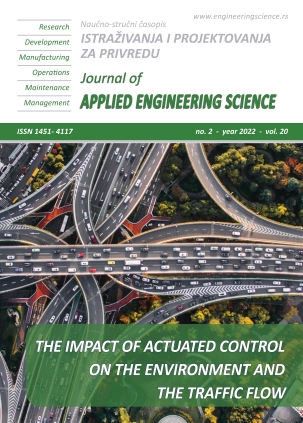A STUDY ON INFLUENCE OF ENVIRONMENTAL WORKING CONDITIONS ON WEAR OF A BALL SCREW BASED ON TCVN7699-2-30
Abstract
Ball screw in a key component of a machine that affects the performance, accuracy working condition, and lifetime of the machines. Temperature and relative humidity (RH) are two environmental factors that affect the assembly condition and lubrication between surfaces. The study proposed an experimental investigation of the influences of the specific environmental working conditions corresponding to the tropical climate and the Vietnamese standardization system TCVN7699-2-30 on wear of a ball screw with serial No. of PSS1505N1D0261. The results show that the ball screw working in the environmentally lubricated conditions according to the TCVN7699-2-30, the longevity increased by 4.18 times as compared to the ISO 3408-5. The fundamentals for calculation and adjustment of the environmental working conditions of the machines with a purpose of ensuring the most feasible operation accuracy of the machines should be recommended based on specific conditions.
References
Sato R., (2011). Wear estimation of ball screw and support bearing based on servo signals in feed drive system. Leading Edge Manufacturing in 21st century : LEM21, p. 3233.1-3233.6.
Wei C.-C., Liou W.-L., Lai R.-S. (2012). Wear analysis of the offset type preloaded ball–screw operating at high speed, Wear, vol. s 292–293, 111–123, DOI: 1016/j.wear.2012.05.024.
Liu X., Mao X., He Y., Liu H., Fan W., Li B., (2016). A new approach to identify the ball screw wear based on feed motor current. Proceedings of the International Conference on Artificial Intelligence and Robotics and the International Conference on Automation, Control and Robotics Engineering, p. 1-5.
Liu D.-S., Lin P.-C., Lin J.-J., Wang C.-R., Shiau T.-N. (2019). Effect of environmental temperature on dynamic behavior of an adjustable preload double-nut ball screw, The International Journal of Advanced Manufacturing Technology, vol. 101, no. 9-12, 2761-2770, DOI: 1007/s00170-018-2966-x.
Zhou C.-G., Zhou H.-X., Feng H.-T. (2020). Experimental analysis of the wear coefficient of double-nut ball screws, Wear, vol. 446-447, 1-12, DOI: 1016/j.wear.2020.203201.
Zhou H.-X., Zhou C., Feng H.-T., Ou Y. (2020). Theoretical and experimental analysis of the preload degradation of double-nut ball screws, Precision Engineering, vol. 65, 72-90, DOI: 1016/j.precisioneng.2020.04.012.
Cheng Q., Liu Z., Zhang C., Xue D. (2019). An accuracy degradation analysis of ball screw mechanism considering time-varying motion and loading working conditions, Mechanism and Machine Theory, vol. 134, 1-23, DOI: 1016/j.mechmachtheory.2018.12.024.
Zhou C.-G., Feng H.-T., Ou Y. (2018). A new model for predicting the mechanical efficiency of ball screws based on the empirical equations for the friction torque of rolling bearings, Advances in Mechanical Engineering, vol. 10, no. 9, 1-8, DOI: 1177/1687814018800173.
Olaru D., Puiu G. C., Balan L. C., Puiu V. (2005). Chapter 20. D. Talabă and T. Roche, Product Engineering: Eco-Design, Technologies and Green Energy. Springer Netherlands, Dordrecht, p. 333-346.
Zhang L.-C., Zu L. (2019). A new method to calculate the friction coefficient of ball screws based on the thermal equilibrium, Advances in Mechanical Engineering, vol. 11, no. 1, 1-5, DOI: 1177/1687814018820731.
Tuan N. A., Y N. D., Van Hung P., Thai N. N. (1993). The wear of material in humid-tropical conditions, Wear, vol. 162-164, 1066-1067, DOI: 1016/0043-1648(93)90124-5.
TCVN 7699-2-30 : 2007 Environmental testing - Part 2-30: Tests - Test A: Damp heat, cyclic (12 h+ 12 h cycle) (2007).
Nguyen A.-T., Pham V.-H. (2005). Tribology. Science and Technics Publishing House, Hanoi.

